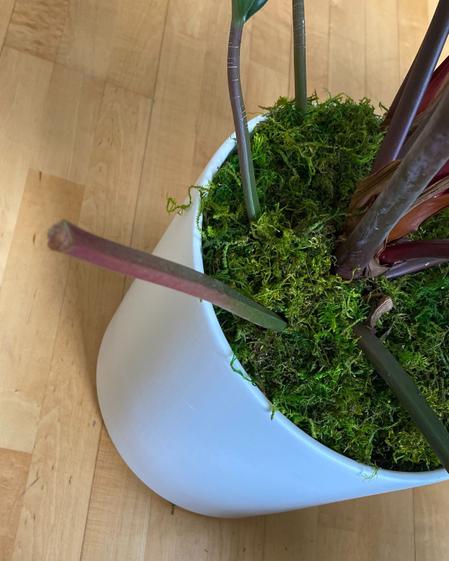Red Congo Care Guide

The Philodendron Red Congo or simply the Red Congo is a bold, tropical houseplant known for its lush, upright growth and striking red-tinted stems and new leaves. Unlike vining philodendrons, this self-heading variety grows in a tidy rosette, making it perfect for adding a sculptural touch to your space. Its broad, glossy leaves emerge burgundy or deep red before maturing to rich green, giving it a dynamic and dramatic look. Easy to care for and rewarding to grow, the Red Congo is a favorite for anyone looking to add a touch of the exotic to their interiors. Read on to learn how to keep this showstopper thriving.
Simple Care Instructions for the Red Congo
Light Requirements
Red Congos thrive in bright, indirect light and can tolerate moderate light conditions. While it won’t mind a slightly dim corner, more light will encourage stronger growth and more vibrant foliage color. Avoid direct sunlight, which can scorch the leaves and fade the red tones. If you notice leggy or slow growth, try moving it to a brighter spot.
Watering Needs
Red Congos prefer evenly moist soil but should never sit in soggy conditions. Allow the top 1–2 inches of soil to dry out between waterings. This plant is more tolerant of underwatering than overwatering, and keeping it too wet is a common cause of stress or root rot. A consistent routine works best, typically watering every 1–2 weeks, adjusting for your space’s light and humidity.
Need some watering support? Use a moisture meter to always know the best time to water your Red Congo. Shop our favorite minimalist moisture meter here.
Humidity and Temperature
Philodendron Red Congo appreciates moderate to high humidity but adapts well to average indoor levels. To keep leaves glossy and healthy, especially during dry seasons, consider misting occasionally or using a humidifier. Avoid placing it near heating vents or air conditioners, which can dry it out.
Ideal temperatures range between 65–80°F (18–27°C). Keep away from drafts, open windows in winter, or sudden cold snaps—prolonged exposure to temperatures below 55°F (13°C) can lead to damage or slowed growth.
Soil and Fertilizing
The Red Congo does best in a loose, well-draining soil mix that holds some moisture but doesn’t stay soggy. Choose a premium indoor potting mix with ingredients like perlite, bark, or coco coir for airflow and drainage.
During the growing season (spring and summer), feed monthly with a balanced liquid fertilizer. This will support steady growth and leaf production. Reduce or pause feeding in fall and winter when growth naturally slows down.
Common Problems and Troubleshooting Tips
Yellow Leaves – Overwatering or Low Light
Symptoms: Older leaves turning yellow, especially near the base.
Cause: Too much water is the most common reason, but insufficient light can also play a role.
Solution: Check the soil moisture and drainage. If it's consistently wet, reduce watering frequency and make sure the pot drains well. Move the plant to a brighter area if needed. Prune yellowing leaves to maintain the plant’s neat appearance.
Brown Edges or Spots – Low Humidity or Overwatering
Symptoms: Brown, crispy edges or soft brown spots on the leaves.
Cause: Dry air or inconsistent watering can lead to crisp edges, while soggy soil may cause soft spots.
Solution: If the air is very dry, try increasing humidity with a humidifier or pebble tray. If the spots are soft or blackened, inspect for root rot and adjust watering accordingly. Remove affected leaves and avoid waterlogged soil.
Wilting or Drooping – Improper Watering or Temperature Stress
Symptoms: Leaves or stems appear limp and droopy.
Cause: This can be due to under- or overwatering, or sudden cold exposure.
Solution: Check soil moisture—if dry, water thoroughly. If wet, let the soil dry out and ensure proper drainage. Avoid placing the plant in cold or drafty areas. Stable, warm temperatures help prevent wilting.
Slow Growth or Small Leaves – Not Enough Light or Nutrients
Symptoms: New leaves are smaller than usual, and overall growth is sluggish.
Cause: Red Congo needs enough light and nutrients to grow to its full potential.
Solution: Move to a spot with more bright, indirect light and resume monthly feeding in spring and summer. Prune lightly to encourage fuller growth if needed.
Leaf Loss – Natural Aging or Environmental Stress
Symptoms: Occasional loss of lower leaves.
Cause: Losing older leaves is normal, but sudden or excessive leaf drop can signal watering issues or environmental changes like temperature drops.
Solution: Maintain a consistent care routine. Make sure the plant is not overwatered, and avoid moving it frequently. A little leaf loss now and then is nothing to worry about—just part of the plant’s natural cycle.

Leaf drop due to environmental changes (ie sudden temperature drop)
Seasonal Care Tips
In spring and summer, your Red Congo will be actively growing and may produce new leaves every few weeks. Water a bit more often and feed monthly to support healthy growth. In fall and winter, the plant slows down—reduce watering and stop fertilizing during this time.
Watch for changes in light throughout the seasons. If your space becomes darker in winter, consider moving the plant closer to a bright window or using a grow light to maintain healthy foliage. Keep away from cold drafts and maintain stable indoor temps for year-round success.




